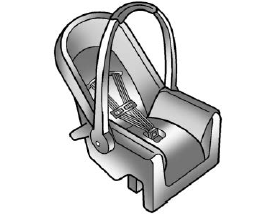Chevrolet Silverado: Wheels and Tires / If a Tire Goes Flat
It is unusual for a tire to blowout while driving, especially if the tires are maintained properly. If air goes out of a tire, it is much more likely to leak out slowly. But if there ever is a blowout, here are a few tips about what to expect and what to do:
If a front tire fails, the flat tire creates a drag that pulls the vehicle toward that side. Take your foot off the accelerator pedal and grip the steering wheel firmly. Steer to maintain lane position, and then gently brake to a stop, well off the road, if possible.
A rear blowout, particularly on a curve, acts much like a skid and may require the same correction as used in a skid. Stop pressing the accelerator pedal and steer to straighten the vehicle. It may be very bumpy and noisy. Gently brake to a stop, well off the road, if possible.
Warning
Driving on a flat tire will cause permanent damage to the tire. Re-inflating a tire after it has been driven on while severely underinflated or flat may cause a blowout and a serious crash. Never attempt to re-inflate a tire that has been driven on while severely underinflated or flat. Have your dealer or an authorized tire service center repair or replace the flat tire as soon as possible.
Warning
Lifting a vehicle and getting under it to do maintenance or repairs is dangerous without the appropriate safety equipment and training. If a jack is provided with the vehicle, it is designed only for changing a flat tire. If it is used for anything else, you or others could be badly injured or killed if the vehicle slips off the jack. If a jack is provided with the vehicle, only use it for changing a flat tire.
If a tire goes flat, avoid further tire and wheel damage by driving slowly to a level place, well off the road, if possible. Turn on the hazard warning flashers. See Hazard Warning Flashers.
Warning
Changing a tire can be dangerous. The vehicle can slip off the jack and roll over or fall causing injury or death. Find a level place to change the tire. To help prevent the vehicle from moving:
- Set the parking brake firmly.
- Put the shift lever in P (Park).
- For vehicles with four-wheel drive with an N (Neutral) transfer case position, be sure the transfer case is in a drive gear — not in N (Neutral).
- Turn off the engine and do not restart while the vehicle is raised.
- Do not allow passengers to remain in the vehicle.
- Place wheel blocks, if equipped, on both sides of the tire at the opposite corner of the tire being changed.
When the vehicle has a flat tire (2), use the following example as a guide to assist in the placement of the wheel blocks (1), if equipped.

- Wheel Block (If Equipped)
- Flat Tire
The following information explains how to use the jack and change a tire.
 Tire Chains
Tire Chains
Warning
If the vehicle has LT275/65R18, 275/60R20, LT275/65R20, or 275/50R22 size
tires, do not use tire chains. If the vehicle is a 1500 Series with LT265/70R17
size tires, do not use tire chains...
 Tire Changing
Tire Changing
Removing the Spare Tire and Tools
Jack
Jack Knob
Tool Kit
Wing Nut Retaining Tool Kit
Wheel Blocks
Wing Nut Retaining Wheel Blocks
The equipment is under the second row seats, if equipped, or behind the front
row seats on regular cab models...
Other information:
Chevrolet Silverado 2019-2025 Owners Manual: Steering Column Lock
If equipped, the steering column lock is a theft-deterrent device. This feature locks the steering column when the vehicle is turned off and the driver door is opened, or when the driver door is opened and then the vehicle is turned off. The steering column unlocks when the vehicle is turned on...
Chevrolet Silverado 2019-2025 Owners Manual: Why Seat Belts Work
When riding in a vehicle, you travel as fast as the vehicle does. If the vehicle stops suddenly, you keep going until something stops you. It could be the windshield, the instrument panel, or the seat belts! When you wear a seat belt, you and the vehicle slow down together...
Categories
- Manuals Home
- 4th Generation Silverado Owners Manual
- 4th Generation Silverado Service Manual
- Engine Compartment Fuse Block
- Electronic Stability Control (ESC) Off Light
- Heated Steering Wheel
- New on site
- Most important about car
Child Restraint Systems

Rear-Facing Infant Restraint
A rear-facing child restraint provides restraint with the seating surface against the back of the infant.
